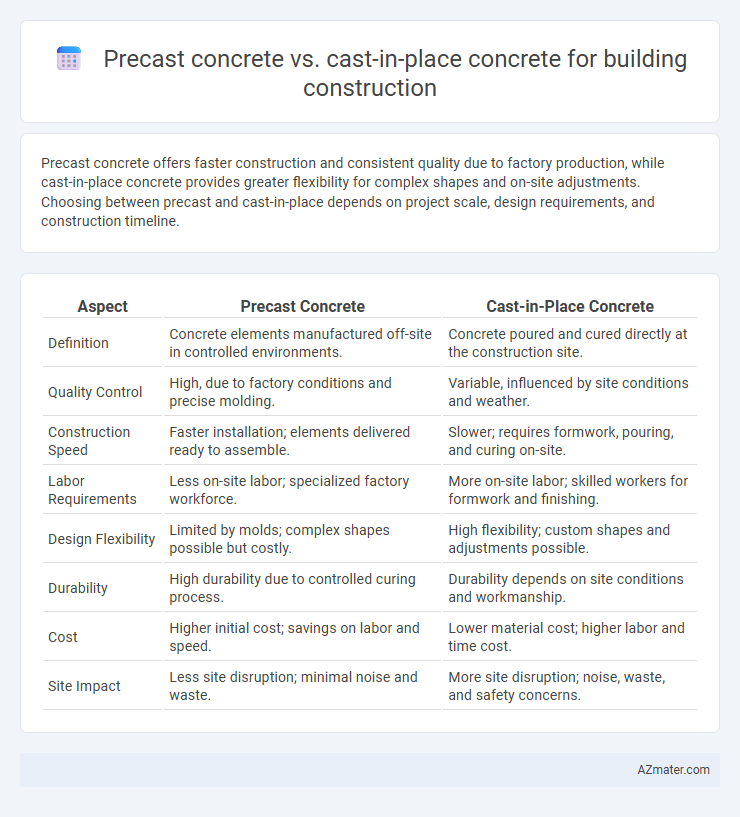Precast concrete offers faster construction and consistent quality due to factory production, while cast-in-place concrete provides greater flexibility for complex shapes and on-site adjustments. Choosing between precast and cast-in-place depends on project scale, design requirements, and construction timeline.
Table of Comparison
| Aspect | Precast Concrete | Cast-in-Place Concrete |
|---|---|---|
| Definition | Concrete elements manufactured off-site in controlled environments. | Concrete poured and cured directly at the construction site. |
| Quality Control | High, due to factory conditions and precise molding. | Variable, influenced by site conditions and weather. |
| Construction Speed | Faster installation; elements delivered ready to assemble. | Slower; requires formwork, pouring, and curing on-site. |
| Labor Requirements | Less on-site labor; specialized factory workforce. | More on-site labor; skilled workers for formwork and finishing. |
| Design Flexibility | Limited by molds; complex shapes possible but costly. | High flexibility; custom shapes and adjustments possible. |
| Durability | High durability due to controlled curing process. | Durability depends on site conditions and workmanship. |
| Cost | Higher initial cost; savings on labor and speed. | Lower material cost; higher labor and time cost. |
| Site Impact | Less site disruption; minimal noise and waste. | More site disruption; noise, waste, and safety concerns. |
Introduction to Precast and Cast-in-Place Concrete
Precast concrete involves manufacturing concrete elements in a controlled factory environment, allowing for high precision and quality control before transporting them to the construction site. Cast-in-place concrete is poured and cured directly onsite, facilitating customization and integration with structural components during the building process. The choice between precast and cast-in-place concrete depends on project requirements such as construction speed, labor availability, structural complexity, and site conditions.
Overview of Precast Concrete
Precast concrete involves casting concrete elements in a controlled factory environment before transporting them to the construction site, ensuring high quality and uniformity. This method accelerates construction timelines and reduces on-site labor costs compared to cast-in-place concrete, which is mixed and poured directly at the site. Precast concrete components offer enhanced durability, precise dimensions, and improved resistance to environmental factors, making them ideal for modular building applications.
Overview of Cast-in-Place Concrete
Cast-in-place concrete involves pouring concrete into formwork directly at the construction site, allowing for customized shapes and onsite adjustments to structural elements. This method provides high structural integrity and seamless monolithic strength by curing in place, making it ideal for foundations, walls, and columns in complex building designs. Despite longer construction times and weather dependency, cast-in-place concrete offers superior adaptability and integration with other building components compared to precast alternatives.
Material Quality and Consistency
Precast concrete offers superior material quality and consistency due to controlled factory environments where precise mixing, curing, and quality checks occur, reducing variability and defects common on construction sites. Cast-in-place concrete quality depends heavily on on-site conditions, skilled labor, and environmental factors, which can lead to inconsistencies in strength and finish. Strict factory protocols in precasting ensure uniform density, reduced porosity, and optimized concrete strength that enhances building durability and structural performance.
Construction Speed and Efficiency
Precast concrete significantly accelerates construction speed by allowing components to be manufactured off-site simultaneously with site preparation, leading to faster project completion compared to cast-in-place concrete, which requires on-site curing time. Efficiency improves as precast elements reduce labor costs and minimize weather-related delays, ensuring consistent quality controlled in factory conditions. Conversely, cast-in-place concrete offers flexibility for complex designs but often extends project timelines due to formwork setup, pouring, and extended curing periods.
Cost Comparison
Precast concrete typically offers lower labor costs and faster on-site assembly compared to cast-in-place concrete, reducing overall construction timelines and expenses. Cast-in-place concrete involves higher formwork and curing costs, as well as increased labor intensity, leading to elevated total project expenditures. While precast concrete requires upfront manufacturing investment, its repetitive use and quality control contribute to long-term cost efficiency in building construction.
Design Flexibility and Architectural Aesthetics
Precast concrete offers limited design flexibility due to factory-controlled production, but allows precise architectural aesthetics with consistent finishes and complex shapes. Cast-in-place concrete provides greater design freedom on-site, enabling customized forms and intricate architectural details tailored to specific projects. Architects often balance the rigid precast options with the adaptable cast-in-place methods to achieve both structural efficiency and unique building aesthetics.
Structural Performance and Durability
Precast concrete demonstrates superior structural performance through controlled factory conditions that ensure consistent strength, reduced shrinkage, and higher durability compared to cast-in-place concrete. Cast-in-place concrete provides better adaptability to complex site conditions but is more susceptible to environmental influences like curing variability and shrinkage cracks that can compromise durability. The enhanced quality control in precast concrete results in improved resistance to weathering, chemical attacks, and freeze-thaw cycles, making it preferable for long-term structural integrity.
Sustainability and Environmental Impact
Precast concrete reduces waste and energy consumption by manufacturing components in controlled factory settings, ensuring precise material usage and minimizing onsite disruption. Cast-in-place concrete often results in higher carbon emissions due to prolonged curing times and increased onsite machinery use, raising its overall environmental footprint. Sustainable building projects favor precast concrete for its recyclability, reduced transportation emissions, and ability to integrate recycled aggregates, significantly lowering lifecycle environmental impacts.
Choosing the Right Method for Your Project
Precast concrete offers rapid installation, superior quality control, and reduced site labor, making it ideal for projects with tight schedules and repetitive designs. Cast-in-place concrete provides greater flexibility for complex shapes and on-site adjustments, suitable for customized architectural features or irregular site conditions. Evaluating project timeline, design complexity, budget, and site constraints ensures choosing the optimal concrete method for structural integrity and cost efficiency.

Infographic: Precast concrete vs Cast-in-place concrete for Building construction
 azmater.com
azmater.com